MySocialBeIng: Mycenaean Social Belonging from an Integrative Bioarchaeological Perspective
MySocialBeIng - Mycenaean Social Belonging from an Integrative Bioarchaeological Perspective
ERC Consolidator grant 2021

- Project Leader: Philipp W. Stockhammer
- Project Members: please click here
- ERC Consolidator Grant Budget: 1,999,751.25 €, financed by the European Research Council
- Project term: 01.01.2022–31.12.2026
When Heinrich Schliemann excavated the famous shaft graves of Mycenae in 1876, his rich findings attracted worldwide attention to this previously little-known prehistoric culture which kept fascinating a broad audience until now. Subsequently, the Late Bronze Age (LBA) of the 2nd mill. BC on the Greek Mainland was called “Mycenaean”, a modern term used broadly for LBA societies of Greece since then. The fact that several human individuals used to be buried together in the same grave already raised Schliemann’s thoughts about their social relationship. Believing in the historicity of the Homeric epics, Schliemann identified them as Agamemnon and his family and thereby initiated the debate about social belonging in Mycenaean Greece, which has still not been solved.
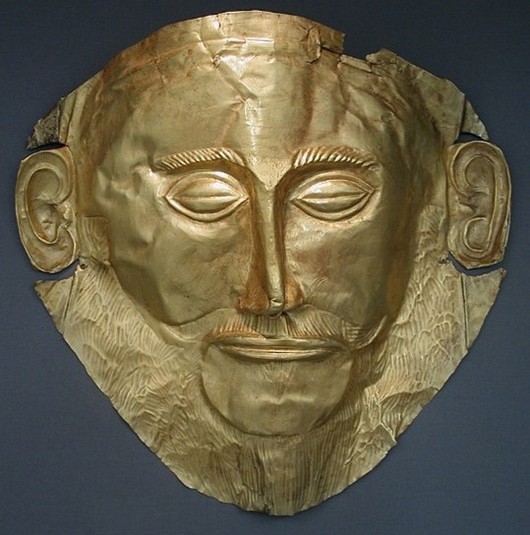
Funeral gold mask from Mycenae attributed to “Agamemnon” (image: DieBuche 2005, CC BY-SA 3.0, https://commons.wikimedia.org/wiki/File:MaskeAgamemnon.JPG).
In the past 100 years, hundreds of LBA collective graves of different types have been excavated on the Greek Mainland – from single tholos tombs to large chamber tomb cemeteries with hundreds of individuals buried in them – and these burials have become one of the hallmarks of the Mycenaean Era.
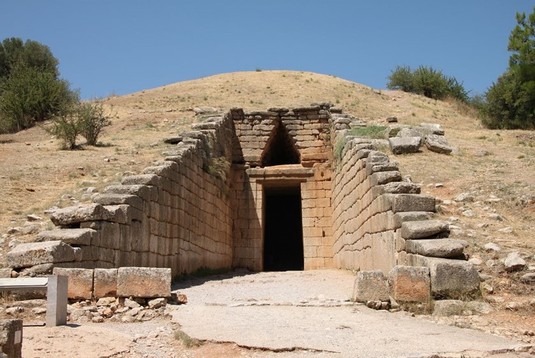
Tholos tomb “Treasury of Atreus” at Mycenae (image: Klearchis Kapoutsis 2010, CC BY 2.0,
https://de.m.wikipedia.org/wiki/Datei:Treasury_of_Atreus_-_Klearchos_Kapoutsis.jpg).
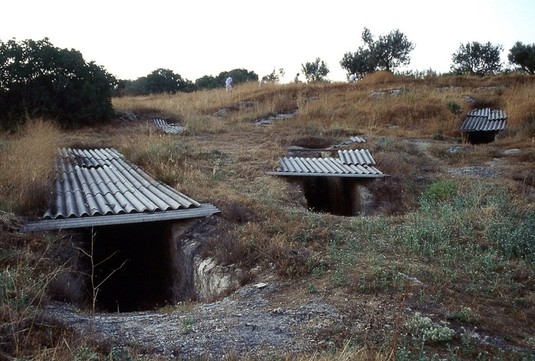
Chamber tombs at Aidonia (image: Mark Landon, 1991, CC BY 4.0, https://commons.wikimedia.org/wiki/File:Aidonia_01.jpg).
It is clear that the selection of individuals for burial in a collective tomb (i.e. a tomb where – over a period of time – several deceased humans were buried) was based on notions of social relatedness between them and that the practices during and after burial at the necropolis also shaped social belonging within the community of the living. However, it is still unclear which factors guided the notions of social belonging which then determined the selection of individuals for the burial in a collective grave. Different terms have been used to name the social relations materialised in the collective graves, e.g. “family”, “kinship”, “household” or “oikos”.
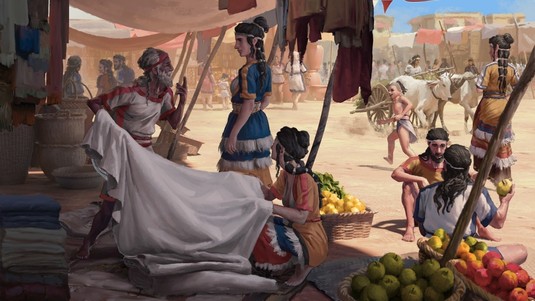
Artist’s impression of a community of the living in Mycenaean Greece (image: Nikola Nevenov).
However, the character of these relations, their formation as well as their transformation over time and their diversity within LBA Greece are still hardly known. The unique wealth of these burials has the potential to serve as a paradigmatic case to overcome one of the key challenges of archaeology, i.e. understanding the complexity of social belonging in the deep past and transcending still dominant simplistic notions of biologically determined prehistoric “families”, a necessity recently pointed out by critical researchers. Sociologists, anthropologists and historians have long been aware of the complexity of social institutions as long as sufficient literary sources and/or participant observation/interviews are available. For ancient Greece and Rome, the complexity of the oikos and the familia has become clear, which included biologically related and non-related individuals in one social entity, and similar insights have been reached for other early societies with sufficient textual and archaeological sources e.g. Pharaonic Egypt. As soon as these sources fade out, biological determinism will usually enter archaeological interpretation. Whereas Mycenaean literary sources inform us about the importance of human mobility and the structure of the different palace-based states, our knowledge about their social organisation beyond palatial administration is limited. It is now time to unravel the constitution of social belonging out of the dialectical interplay of biological relatedness and social practices and rethink the constituents of social structures in the past by applying a cutting-edge integrative bioarchaeological approach to the outstanding archaeological source material of the Mycenaean Era. Novel insights into the complexities of Mycenaean societies beyond the elites will not only revolutionise our understanding of LBA Greece and answer long-standing questions but also help to further establish an innovative integrative bioarchaeological approach and enable a deep historical understanding of the complexities of historic and present-day social relationships.
The main focus of the first 18 months of the project was the archaeological sampling and the archaeological contextualisation of the samples as well as the scientific lab analyses, especially the aDNA analyses. All relevant samples have reached the laboratory. The archaeological evaluation and contextualisation have gained momentum. We were even able to publish two ground-breaking articles: First, Skourtanioti et al. 2023 (https://doi.org/10.1038/s41559-022-01952-3) shedding a revolutionary new light on social belonging in the Bronze Age Aegean and esp. unravelling the great importance of cousin-cousin marriage which in its scale in the Bronze Age Aegean is unprecedented throughout human prehistory to this day. Moreover, we were able to construct the first family pedigree ever generated for the ancient Mediterranean.
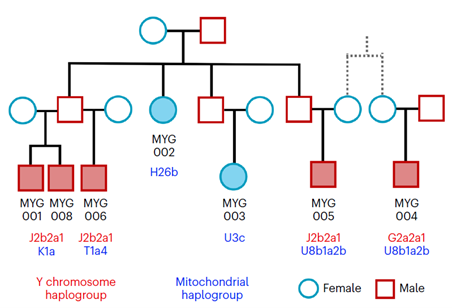
Reconstruction of the family tree for six infants from a burial at Mygdalia (image: Skourtanioti et al. 2023, fig. 5).
Our results have also found great media interest and were featured by more than 120 news outlets all around the world (all countries of Europe and Southern America, USA, Mexico, Russia, Vietnam, China etc.) and in most prominent outlets (e.g. CNN, New York Post, Yahoo News, Tagesspiegel, Kathemerini, El Tiempo, The Times).
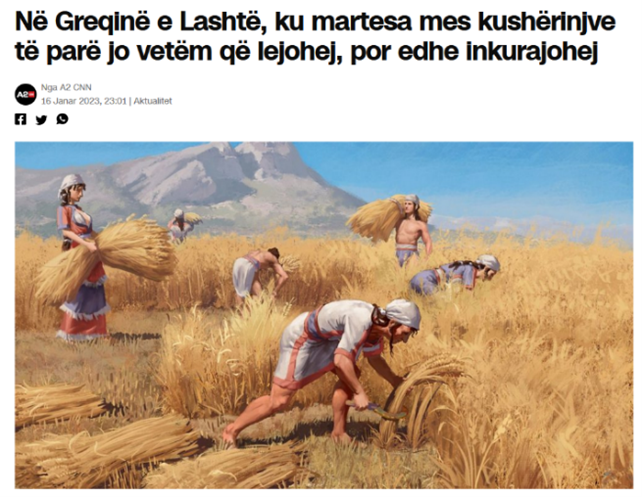
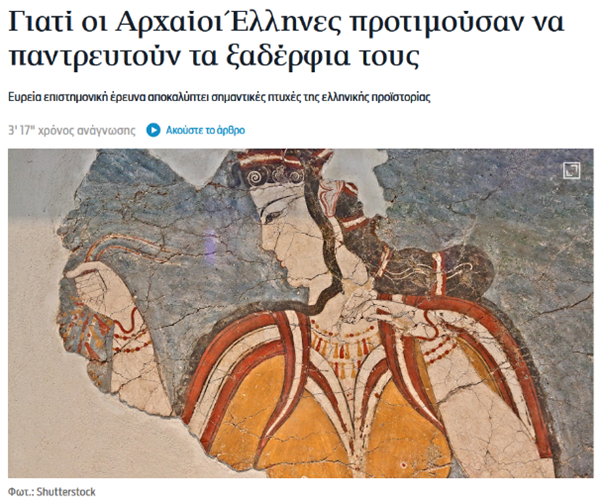
Examples of international news reports from Albania and Greece (image: https://a2news.com/2023/01/16/ne-greqine-e-lashte-ku-martesa-mes-kusherinjve-te-pare-jo-vetem-qe-lejohej-por-edhe-inkurajohej/ and https://www.kathimerini.gr/life/science/562232383/giati-oi-archaioi-ellines-protimoysan-na-pantreytoyn-ta-xaderfia-toys/).
With this paper, MySocialBeIng has already managed to completely transform our understanding of social belonging in the Bronze Age Aegean. To build the methodological basis for the radiocarbon modelling, we collaborated with radiocarbon specialists on a methods paper in year 1 and have been able to publish this as Massy et al. 2022 in PlosOne (https://doi.org/10.1371/journal.pone.0270374). After 18 months, we are now amid lab analyses and further evaluation of datasets, which are promising additional great results. The first DNA screening for the site of Elateia, i.e. the necropolis with the most samples to be studied within MySocialBeIng, indicated very promising overall DNA preservation. We are now looking forward to the production of DNA capture data sets and their subsequent evaluation and integration with the archaeological record.
MySocialBeIng has already revolutionised our understanding of social belonging in the Bronze Age Aegean. According to the present state of research, no other region in human prehistory was marked by such a high degree of cousin-cousin marriage which requires a particular explanation. The societal importance of this practice demands further reflection to trace its origins, reasons and long-term societal impact. Moreover, the project has been able to generate the first biological pedigree for individuals living in the same architectural entity, which has demonstrated that both - biological and cultural - aspects played a decisive role in the living together of human individuals. These insights are only the first of their kind and will now be supplemented by much larger datasets which are currently produced within the project and will be evaluated and published in the months and years to come.
Bibliography
Massy et al. 2022: K. Massy/R. Friedrich/A. Mittnik/P. W. Stockhammer, Pedigree-based Bayesian modelling of radiocarbon dates. PLoS ONE 17(6): e0270374.
https://doi.org/10.1371/journal.pone.0270374
Skourtanioti et al. 2023: E. Skourtanioti/H. Ringbauer/G. A. Gnecchi Ruscone/R. A. Bianco/M. Burri/C. Freund/A. Furtwängler/N. F. Gomes Martins/F. Knolle/G. U. Neumann/A. Tiliakou/A. Agelarakis/M. Andreadaki-Vlazaki/P. Betancourt/B. P. Hallager/O. A. Jones/O. Kakavogianni/A. Kanta/P. Karkanas/E. Kataki/K. Kissas/R. Koehl/L. Kvapil/J. Maran/P. J. P. McGeorge/A. Papadimitriou/A. Papathanasiou/L. Papazoglou-Manioudaki/K. Paschalidis/N. Polychronakou-Sgouritsa/S. Preve/E.-A. Prevedorou/G. Price/E. Protopapadaki/T. Schmidt-Schultz/M. Schultz/K. Shelton/M. H. Wiener/J. Krause/C. Jeong/P. W. Stockhammer, Ancient DNA reveals admixture history and endogamy in the prehistoric Aegean. Nature ecology & evolution January 2023.
https://doi.org/10.1038/s41559-022-01952-3

